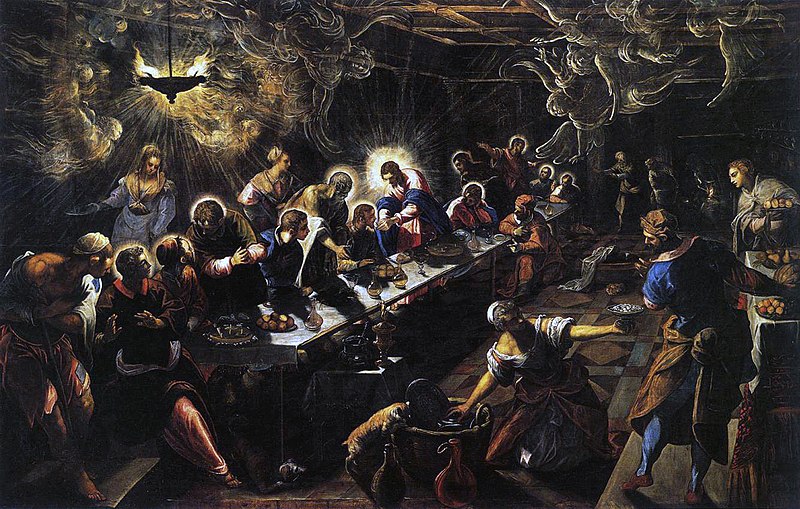Tintoretto and Veronese
Tintoretto
Jacopo Robusti, known as Tintoretto (1518-1594), claimed to be a student of Titian and aspired to combine Titian’s color with Michelangelo’s drawing, but art historians consider Tintoretto the outstanding Venetian representative of Mannerism. In his Last Supper, the figures appear in a dark interior illuminated by a single light the upper left of the image. The shimmering halos establish the biblical nature of the scene. Tintoretto’s Last Supper incorporates many Mannerist devices, including an imbalanced composition and visual complexity. In terms of design, the contrast with Leonardo’s Last Supper is both extreme and instructive.

Leonardo’s composition, balanced and symmetrical parallels the picture plane in a geometrically organized and closed space. The figure of Jesus is the tranquil center of the drama and perspective focus. In Tintoretto’s painting, Jesus is above and beyond the converging perspective lines racing diagonally away from the picture surface, creating disturbing effects of limitless depth and motion. The viewer locates Tintoretto’s Jesus via the light flaring, beaconlike, out of the darkness. The contrast of the two pictures reflects the direction Renaissance painting took in the sixteenth century, as it moved away from architectonic clarity of space and neutral lighting toward the dynamic perspectives and dramatic chiaroscuro of the coming Baroque.

Veronese
Among the great Venetian masters was Paolo Caliari of Verona, called Paolo Veronese (1528-1588). Whereas Tintoretto gloried in monumental drama and deep perspectives, Veronese specialized in splendid pageantry painting in superb color and set within majestic classical architecture. Like Tintoretto, Veronese painted on a huge scale, with canvases often as large as 20 by 30 feet or more.

Veronese painted Christ in the House of Levi, originally called Last Supper, for the dining hall of Santi Giovanni e Paolo in Venice. His shimmering colors span the whole spectrum, although he avoided solid colors in favor of half shades (light blues, sea greens, lemon yellows, roses, and violets), creating veritable flowerbeds of tone. In a great open loggia framed by three monumental arches, Christ sits at the center of the splendidly garbed elite of Venice.

In the foreground, with a courtly gesture, the very image of factious grandeur, the chief steward welcomes guests. Robed lords, their colorful retainers, dogs, and dwarfs crowd into the spacious loggia. Also present are exotic figures wearing turbans, and others of African descent.

Painted in 1573 during the Counter-Reformation [which you will learn about in a future module] this depiction prompted criticism from the Catholic Church. The Holy Office of the Inquisition put the painter on trial, accusing Veronese of impiety for painting “lowly creatures” so close to the Lord and ordering him to make changes at his own expense within three months. Reluctant to do so, he simply changed the painting’s title, converting the subject to a less solemn one. His patrons were quite amenable to this solution, for they found nothing objectionable in the painting. Magnificent feasts and carnivals were a source of pride for Venetians.[1]
In the next page, you will read the transcript of Veronese’s trial. Notice how bold he is in refuting the criticisms of the Inquisition.
- Fred S. Kleiner, Gardner’s Art Through the Ages: The Western Perspective, vol. 2, 15th ed., (Boston: Cengage Learning, 2017), 542-543. ↵

